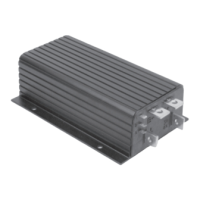30
Curtis PMC 1204/1205 Manual
TROUBLESHOOTING & BENCH TESTING
stop to nearly contacting the pedal-down stop. If the mechanical
operation looks okay, replace the potbox.
3-C While you have the potbox wires off the controller, use an ohmmeter
to check for shorts between these wires and the vehicle frame. You
should see a resistance of at least 1 megohm. If it is lower than that,
inspect the wiring for damaged insulation or contact with acid. If
necessary, replace the potbox.
3-D Push the wires back on the controller terminals. It doesn’t matter
which wire goes on which terminal.
3-E Inspect the terminal area of the controller closely. Occasionally a
buildup of dirt or acid residue of a conductive nature causes electrical
leakage between the throttle input terminals and the B- or M-
terminals, leading to faulty controller operation. To check for this
problem, measure the voltage at the appropriate throttle input
terminal (upper for 0–5kΩ pots, lower for 5kΩ–0 pots), by connect-
ing the voltmeter (-) lead to the controller’s B- terminal. The
keyswitch must be on and a direction selected for this test.
ACCELERATOR INPUT VOLTAGE (in volts)
STANDARD
0–5kΩ POT 5kΩ–0 POT
UPPER TERMINAL LOWER TERMINAL
Pedal up: 3.8 4.3
Pedal down: 9.5 10.2
Compare your readings with these; if they are different by more than
a few tenths of a volt, contamination is probably the cause.
3-F Carefully clean off the terminal area of the controller with a cotton
swab or clean rag moistened with water, and dry thoroughly.
Be sure to turn everything off
before cleaning.
Now test the controller to see if proper operation is restored. If so,
take steps to prevent this from happening again: dirt and water must
be kept from reaching the terminal area of the controller. If the
voltages are still out of range, the controller is at fault and should be
replaced.
☞
CAUTION

